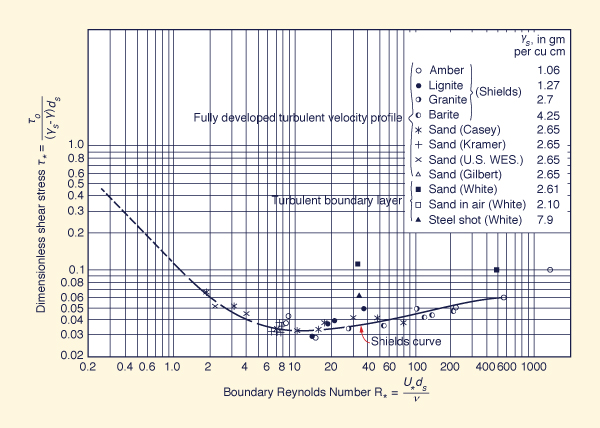1. INTRODUCTION The principle of initiation of motion for flow in a sand-bed channel was pioneered by Shields (American Society of Civil Engineers, 1975; p. 96). The Shields curve is the threshold at which bed-material sediment particles start to move (Fig. 1). This threshold is important in channel design in order to ensure sediment movement and avoid clogging. In this article we express the Shields criterion in terms of the Froude number and related mean velocity required for initiation of motion in a sand-bed channel. To round up the experience, we develop an iterative algorithm to calculate these values online.
2. THE SHIELDS CRITERION
The Shields criterion for initiation of motion
relates the dimensionless shear stress τ*
with the boundary Reynolds number R*
as shown in Figure 1.
The solid curve separates motion above the curve from no motion below the curve.
The Shields criterion is:
in which τo = bottom shear stress,
γs = specific weight of
sediment particles, γ = specific weight of water, ds = sediment
particle diameter, and τ*c = dimensionless critical shear stress.
3. THE FROUDE CRITERION The Froude number is:
in which g = gravitational acceleration and D = hydraulic depth. The quadratic friction formula in open-channel flow is (Ponce, 2014):
in which ρ = mass density of water, f = friction factor, equal to 1/8 of the Darcy-Weisbach friction factor fD, and V = mean velocity. Replacing Eqs. 2 and 3 into 1:
In most cases of practical interest, the ratio γs /γ = 2.65. In this case, the Froude number for initiation of motion is:
As a first approximation, the Shields curve suggests an approximately constant value of critical dimensionless shear stress τ*c = 0.04, applicable for a wide range of boundary Reynolds numbers (Fig. 1). Therefore, Eq. 5 reduces to:
The friction factor varies normally in the range 0.002 ≤ f ≤ 0.005,
which corresponds with Darcy-Weisbach friction factors 0.016 ≤
fD ≤ 0.040.
To illustrate,
we assume a midrange value
For a given particle diameter, relative to hydraulic depth, Eq. 7
states the Froude number that must be exceeded to assure initiation of motion.
For instance, for
ds =
Combining Eqs. 2 and 6, the related mean velocity is:
Thus:
4. APPLICATION WITH MANNINGS n
The relationship between friction factor f and Manning's n is (Ponce, 2014):
in which g = gravitational acceleration, n = Manning's n, R = hydraulic radius, and k = a constant
equal to 1 in SI units and 1.486 in U. S. Customary units.
For a hydraulically wide channel: R ≅ D. Replacing Eq. 10 into Eq. 6, the expression for
Froude number in SI units is:
For example, given: D = 1 m, ds = 0.4 mm = 0.0004 m, and n = 0.019:
In U.S. Customary units, the expression for Froude number is:
in which D and ds are given in ft.
For example, given: D = 3.28 ft, ds = 0.4 mm = 0.001312 ft, and n = 0.019:
5. ITERATIVE ALGORITHM
A more precise calculation of Froude number and related mean velocity
may be obtained by using (in
Eq. 5) a dimensionless critical shear stress
obtained from the actual Shields curve, in lieu of the assumed constant value of 0.04.
This procedure, however, requires an iteration.
The following algorithm is suggested.
Assume R*
Use Fig. 1 to find τ*c
Using Eq. 1, calculate τo
Calculate the new value of R* = (U* ds / ν), in which ν =
kinematic viscosity, a function of temperature.
Stop if the new value of R* is close to that assumed in Step 1 (within a certain small tolerance), and use the last
value of τ*c (calculated in Step 2) in Eq. 5;
Otherwise, return to Step 1 and use the new value of R* (calculated in Step 5) as the assumed value and continue the iteration.
Example.
Given the following channel data: particle diameter ds = 0.4 mm, hydraulic depth D = 1 m, dimensionless Darcy-Weisbach friction factor
f = 0.0035, and water temperature T = 20°C.
Calculate the Froude number and related mean velocity at the threshold of
initiation of motion using ONLINE SHIELDS VELOCITY.
ONLINE CALCULATION. Using the iterative algorithm embedded in
ONLINE SHIELDS VELOCITY,
the Froude number is
6. SUMMARY
The classical Shields criterion of sedimentation engineering
is expressed in terms of the Froude number
and related mean velocity required for initiation of motion in a sand-bed channel.
REFERENCES
American Society of Civil Engineers. 1975. Sedimentation Engineering.
ASCE Manuals and Reports on Engineering Practice No. 54.
Ponce, V. M. 2014.
Fundamentals of open-channel hydraulics.
Online textbook.
|
| 221114 |
